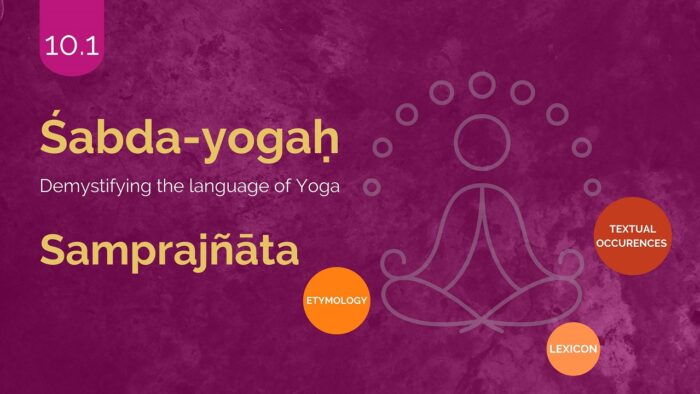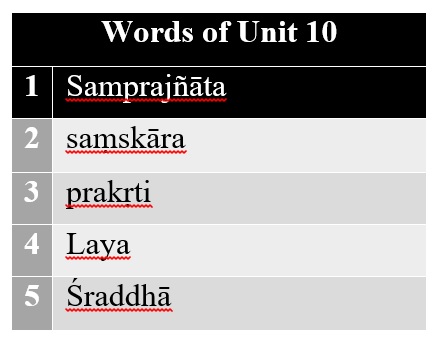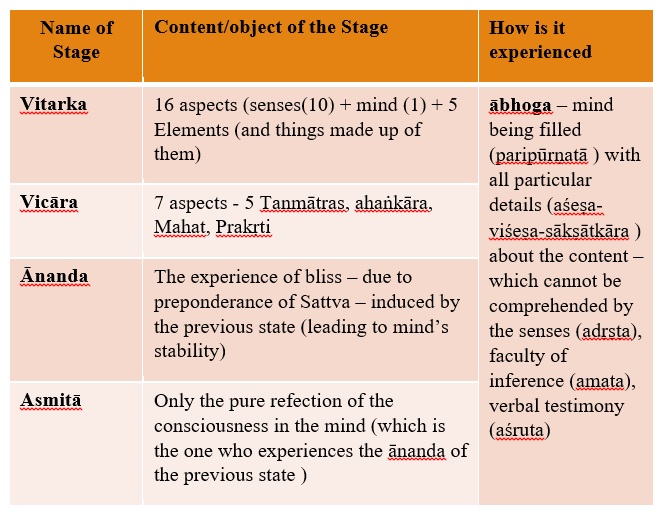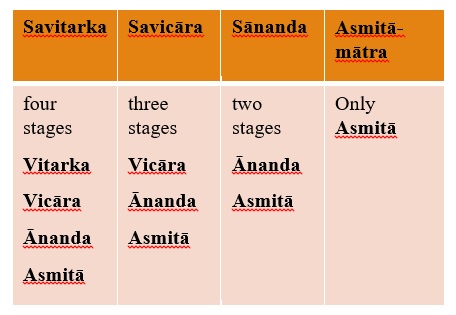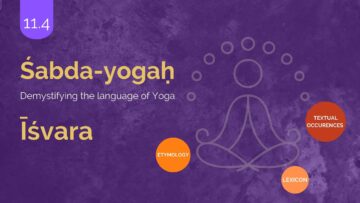Introduction
In this series, Yogic terminologies will be taken up and their –
- Etymological analysis,
- Lexical descriptions and
- Textual occurrences in Yogic literature and their commentaries, as available, will be presented. And finally observations will be made on the references.
Three texts – Yogasūtra, Haṭha-yoga-pradīpikā and Bhagavad-gītā are consulted for textual occurrences portion.
Śabda-yoga is intended to help students, teachers, and professionals of Yoga to develop a sound grammatical, contextual, and thereby an authentic and immersive understanding of Yoga terminologies.
List of Words
We will take up important Yogic terms from Sūtra-s 1.17 – 20 The terms that will be analyzed in this Unit are –
Etymology
सम्+प्र+ज्ञा + क्त = सम्प्रज्ञात
sam+pra+jñā + kta = samprajñāta
In the above etymology –
- The Prefixes are सम्&प्र – sam+pra. The prefix ‘sam’ has been given a host of meanings in the dictionaries[1]. Among them सम्यक् – Samyak – well – is the meaning that has been utilized in the commentaries of Yogasūtra for the current word under consideration.
- Similarly the prefix ‘Pra’ has many meanings[2] – of which in the current context the meaning भृश – exceedingly – seems appropriate.
- The Root word is ज्ञाjñā – which given the meaning – अवबोधन – avabodhana – to know/to realize/ To understand. [3]
- Suffix क्त – kta (going by the view of the commentators of yogasūtra) is added to the root in the sense of instrumentality. No grammatical prescription in this regard is found.
The derivative statement: Going by the above etymological inputs -सम्यक्प्रकर्षेणज्ञायते (वेद्यंवस्तु) येनसः (समाधिः) – samyakprakarṣeṇajñāyate (vedyaṃvastu) yenasaḥ – that (state of Samādhi) by which the object to be known is known exceedingly well.
Lexicon
No entry in the Lexicon is found for this term.
Textual Occurrences
Yogasūtra
The word saṃprajñāta is found in just one sūtra in the text
वितर्कविचारानन्दास्मितारूपानुगमात्संप्रज्ञातः॥१.१७॥
vitarkavicārānandāsmitārūpānugamātsaṃprajñātaḥ .. 1.17 ..
This sūtra describes the state of saṃprajñātaSamādhi. The clear definition of the word saṃprajñāta is seen initially in the commentary of Bhoja, which is later utilized in later commentaries also. The definition is as follows – सम्यक्संशयविपर्ययरहितत्वेनप्रज्ञायतेप्रकर्षेणज्ञायतेभाव्यस्यस्वरूपंयेनससंप्रज्ञातःसमाधिर्भावनाविशेषः – samyaksaṃśayaviparyayarahitatvenaprajñāyateprakarṣeṇajñāyatebhāvyasyasvarūpaṃyenasasaṃprajñātaḥsamādhirbhāvanāviśeṣaḥ – that by which the clear, doubtless, error free knowledge of the object of meditation is known is called as saṃprajñāta –samādhi. It is a kind of visualization.
From the sequence of the Sūtra it could be seen that this state of Samādhi is attained by the twin practices of Abhyasa[4] and Vairagya[5]. As evident from the Sūtra – in general – saṃprajñāta is a state of citta, is attained by the acts of Vitarka, Vicāra, Ānanda and Āsmitā. The four Samādhi oriented acts of the cittaas described by Sage Vyāsa has be tabulated as follows –
Table 1
The Saṃskṛta commentary for the above is as follows – वितर्कश्चित्तस्याऽऽलम्बनेस्थूलआभोगःआनन्दोह्लादः।सूक्ष्मोविचारः।एकात्मिकासंविदस्मिता – vitarkaścittasyā”lambanesthūlaābhogaḥānandohlādaḥ।sūkṣmovicāraḥ।ekātmikāsaṁvidasmitā।
An additional insight on the understanding of the four Samādhi can also be found in the commentary of the Sage Vyāsa – which again has been expressed through the table 2 below. The commentary of Sage Vyāsa on this is as follows – तत्रप्रथमश्चतुष्टयानुगतःसमाधिःसवितर्कः।द्वितीयोवितर्कविकलःसविचारः।तृतीयोविचारविकलःसानन्दः।चतुर्थस्तद्विकलोऽस्मितामात्रइति।tatraprathamaścatuṣṭayānugataḥsamādhiḥsavitarkaḥ।dvitīyovitarkavikalaḥsavicāraḥ।tṛtīyovicāravikalaḥsānandaḥ।caturthastadvikalo’smitāmātraiti।
Table 2
This is the four levels of the saṃprajñātaSamādhi. Attaining mastery in these states to the higher Samādhi called asaṃprajñāta which will be discussed in due course in Śabdayoga.
Bhagavadgītā&Haṭhayogapradīpikā
The term is not found in these texts.
Tabulation on Distribution of References in Yoga Texts 10.1
As evident from the discussion above the term saṃprajñāta is unique to Yogasūtras – not to be found in the other two texts. The inputs from the commentary also indicate that the four stages of the Samādhi are technical terms that have specific connotations with regard to the object of focus. They cannot be generally translated as deliberation, reflection, bliss and Ego. This clarity emerges by the analysis of the term in Śabdayoga.
[1] 37 meanings of the word ‘Sam’ with examples can be seen in Avyaya kosha here – https://archive.org/details/avyaya-kosa-srivatsankacharya/page/364/mode/2up?view=theater
[2] 8 meaning to the word ‘pra’ is given in the Avyayakosha with meanings can be seen here – https://archive.org/details/avyaya-kosa-srivatsankacharya/page/262/mode/2up?view=theater
[3]https://ashtadhyayi.com/dhatu/
[4]https://www.indica.today/long-reads/sabdayoga-the-language-of-yoga-demystified-part-7-5/
[5]https://www.indica.today/quick-reads/sabda-yoga-the-language-of-yoga-demystified-part-7-6/
Unit 10 To be Continued…
Disclaimer: The opinions expressed in this article belong to the author. Indic Today is neither responsible nor liable for the accuracy, completeness, suitability, or validity of any information in the article.

